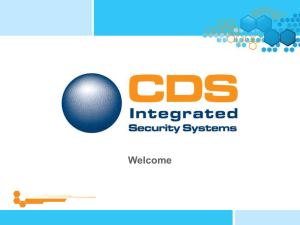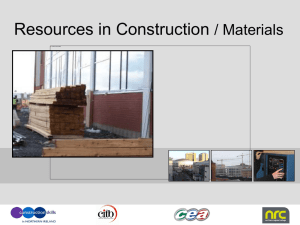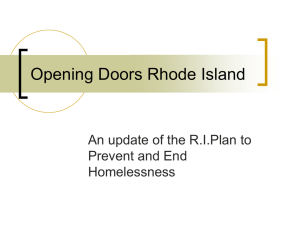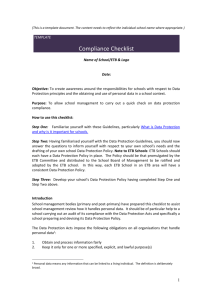Presentation Slides
advertisement
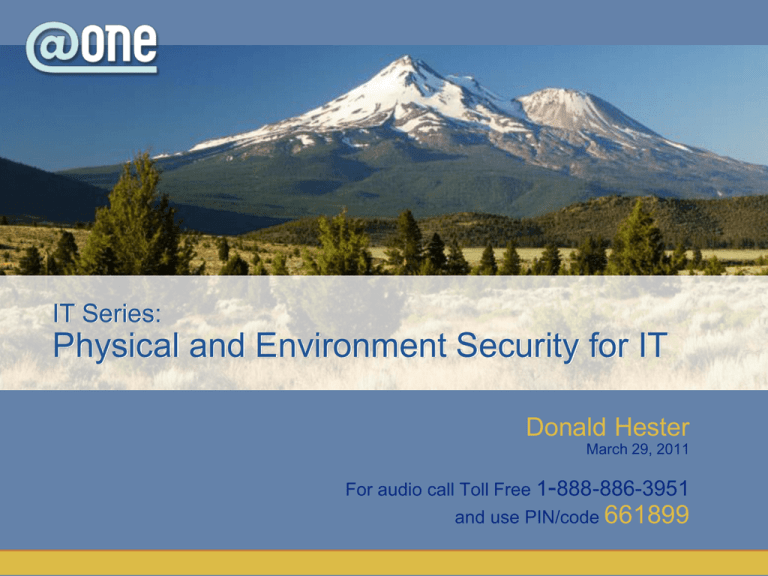
IT Series: Physical and Environment Security for IT Donald Hester March 29, 2011 For audio call Toll Free 1-888-886-3951 and use PIN/code 661899 Housekeeping • Maximize your CCC Confer window. • Phone audio will be in presenter-only mode. • Ask questions and make comments using the chat window. Adjusting Audio 1) If you’re listening on your computer, adjust your volume using the speaker slider. 2) If you’re listening over the phone, click on phone headset. Do not listen on both computer and phone. Saving Files & Open/close Captions 1. Save chat window with floppy disc icon 2. Open/close captioning window with CC icon Emoticons and Polling 1) Raise hand and Emoticons 2) Polling options IT Series: Physical and Environment Security for IT Donald Hester Introduction Topics Covered • Physical security of information systems • Environmental protection of information • system (Not the green type) Some life safety issues Threats Heat (internal and external) Water (leak, flood, weather) Theft Power (loss or spike) Fire (smoke) Natural disaster (earthquake, tornado etc..) Man made disaster (chemical spill) Loss of life 8 Policy Start at the top: • The organization understand the importance and will to commit need resources Policy should: • Addresses purpose, scope, roles, responsibilities, management commitment, coordination among organizational entities, and compliance 9 Granting Physical Access Designate sensitive verses publicly accessible areas List of authorized personnel • To access sensitive areas Review the list regularly • To make sure you remove anyone who no longer needs access 10 Restricted/Sensitive/Secure Areas Selecting Internal areas that need more control Determine what assets require extra security Control access of customers (students) Restrict computer access or LAN access from lobbies Physical Access Control Enforce access authorizations Verify access authorization before granting access Control entry Control publicly accessible areas in accordance with risk Secure keys, combinations, passwords, PINs, and other physical devices 12 Exterior Security Physical Access Control Secure keys, combinations, passwords, PINs, and other physical devices • Key log (who has the keys) • Rekey (when a key is lost) • Recovery (get keys back) • Change combination (like password) Important events • Someone is terminated or leaves • Lost or compromised 14 Physical Access Control Doors • No more than two doors • Locks, or electronic door locks • Strike-plates on doors • Tamper-resistant hinges on doors • Resistant to forcible entry • Fire rated doors and walls • Internal windows should be small and shatter or bullet proof 15 Control Access to Cables Control access to the cables used for communication • Ethernet • Telecom • Wiring closets • Spare jacks • Conduit or cable trays 16 Output Device Access Control What output devices need control? • Printers • Monitors • Audio devices For example HR prints to a printer no one can simple walk by and pick up the print out (restricted area) Same with finance and transcripts Protect from theft 17 Monitoring Monitor physical access • CCTV especially in cash collection sites Log access • Access control devices can log who gained access Netbotz (example not an endorsement) • Detect and respond to incidents 18 CCTV Closed-circuit TV • Wired or wireless Simplest camera connected to TV monitor More complex can detect, recognize, or identify • Smart CCTV – facial recognition technology Purpose to detect & deter also used in investigations CCTV uses Security Applications Safety Applications Management Tool Investigation Tool Visitor control Contractors and employees access to restricted areas Monitor visitor activity Sign in Check ID Did you know they were coming? • Appointment only 21 Access Records Keep records Review records Records should include: • Name/organization of the person visiting • Signature of the visitor • Form(s) of identification • Date of access, time of entry and departure • Purpose of visit • name/organization of person visited 22 Power Concern is loss of power resulting in down time Protect power equipment • Access control to sub panels • Fire code issues Protect power cables • Redundant or parallel power cables 23 Emergency Shutoff Power switch to turn off all system • Life safety issue Server rooms can be equipped with a switch that will turn off all equipment included those on battery backup Place switch in a accessible location Protect switch from accidental activation 24 Emergency Power Provide a short-term uninterruptible power supply to facilitate an orderly shutdown of the information system in the event of a primary power source loss • UPS for short time periods • What is your current UPS rated for? • Is that enough time for a orderly shutdown? • Have you check the battery life lately? 25 Emergency Power Provide a long-term alternate power supply for the information system that is capable of maintaining minimally required operational capability in the event of an extended loss of the primary power source • Power generator • How important is uptime? • How reliable is the power grid? 26 Emergency Lighting Employ and maintains automatic emergency lighting • Life safety issue again • Typically lights are in common areas and • 27 not always in a server room Typically handled by facilities personnel Fire Hazard Fire suppression and detection devices/systems • Fire Prevention • Fire Detection • Fire Alarm • Fire Suppression • Fire Drills 28 Fire Suppression Fire suppression devices/systems Should have an independent power source Properly rated fire extinguisher Sprinklers, dry pipe best Should have automatic shut down of servers Halon FM-200 (or FE-227), FE-13, FE-25, Novec-1230, inert gas systems like Argonite, Inergen or CO2 Toxic fumes from burning plastic 29 Fire Protection 30 Temperature and Humidity Controls Maintains temperature and humidity levels Monitors temperature and humidity levels • Maintain a constant temperature be • between 70-74F (21-23C) Maintain a constant humidity between 45-60% 31 High humidity causes corrosion and low humidity causes static electricity. HVAC Positive air pressure • Air flow out of the room • Limits dust getting in Protected air vents • Possible entry point Filtered air • Dust reduces heat transfer and can cause heat damage to circuits Redundant HVAC systems 32 Water Damage Protection Protects the information system from damage resulting from water leakage Master shutoff valves • Accessible • Working • Known by key personnel Not just for the server room, wire closets Positive flow water drains • Protect from the risk of flooding 33 Delivery and Removal Authorizes, monitors, and controls computer equipment entering or exiting the facility Record of those items Theft is the big issues here 34 Alternate Work Site Part of Business Continuity Planning Consider physical and environment controls in alternate work site 35 Locate Systems Position information system components within the facility to minimize potential damage from physical and environmental hazards and to minimize the opportunity for unauthorized access • Where is the best place in your facility for a • server room? External issues? Proximity of emergency services Offsite hazards 36 Location, Location, Location Avoid the basement Avoid the top floor Avoid the first floor Avoid be located near stairs, bathrooms, water pipes, elevators or EMI emissions Avoid locating it on an external wall Avoid external windows and doors 37 Areas Plenum space • Requires plenum cabling Raised false floors • Access to & protect cabling Drop ceilings can give access to server rooms • Walls should extend beyond any false or drop ceilings Security Mesh to help stop break-ins through gypsum walls 38 Site Security Site Location (Site Survey) • Proximity to emergency services • Flood zones, types of natural • • • events, e.g. earthquake, hurricane, tornado Proximity to hazardous materials, e.g. next to a oil refinery, train tracks Redundant roads or ways in to the area Crime rates for the area Site Location Site Examples Other Site Issues Crime Prevention Through Environmental Design (CPTED) • The building and facilities (campus) are • • • • • 42 designed in such a way as to limit or deter crime. Parking lots & lighting Perimeter lighting Perimeter security Landscaping Barriers (bollards) Information Leakage Tempest Protect the information system from information leakage due to electromagnetic signals emanations 43 Interference Shielding from: • Electromagnetic interference (EMI) • Radio frequency interference (RFI) • Shielded cabling, room Electrostatic discharge (ESD) • Anti-static flooring • Anti-static wrist strap 44 Signage For life safety • Clearly mark exits for life safety • Clearly mark locations of fire extinguishers • Clearly mark shutoff switches and valves For theft • Signs create a psychological barrier • Asset tag equipment for possible recovery 45 Alarm Systems A Communication systems design to alert, warn or notify a receiver of an event or danger. Made up of 3 parts, sensor (detector) that detects the condition, and alarm system circuit to transmit the information to an annunciator (signal, alarm) Standards UL, ISO and IEEE Secure Disposal (End of Life Cycle) Consider security before returning a failed hard drive Data remanence Software Data removers Degauss Shredding Incinerators Dumpster Diving Not illegal Industrial espionage Some consider it a hobby Can find private, confidential information on paper or media or computers Copiers 49 http://www.youtube.com/watch?v=iC38D5am7go Monitoring Tools Netbotz • (now owned by APC) IT WatchDogs • www.itwatchdogs.com APC • www.apc.com SynapSense • www.synapsense.com 50 Q&A Donald E. Hester CISSP, CISA, CAP, MCT, MCITP, MCTS, MCSE Security, Security+, CTT+ Director, Maze & Associates University of San Francisco / San Diego City College / Los Positas College www.LearnSecurity.org | www.linkedin.com/in/donaldehester | www.facebook.com/LearnSec | www.twitter.com/sobca DonaldH@MazeAssociates.com Evaluation Survey Link Help us improve our seminars by filing out a short online evaluation survey at: http://www.surveymonkey.com/s/PhysSecurity IT Series: Physical and Environment Security for IT Thanks for attending For upcoming events and links to recently archived seminars, check the @ONE Web site at: http://onefortraining.org/
